9
Learning Objectives
By the end of this chapter, you should be able to,
- understand c-command
- recognize the difference between R-expressions, pronouns, and anaphors
- understand their distributional differences
- restate the three binding conditions (A, B, and C)
- understand how the distribution of referring expressions is constrained by binding theory
In this chapter we’ll change gears a little. We are now going to be concerned for the first time with what are apparently non-local dependencies. By this I mean that we are going to be looking at things that interact over a syntactic distance; they aren’t next to each other in the tree. We’ve sort of been hinting at this (e.g., with head-movement in chapter 7) but now we’ll delve into some real cases.
Besides introducing Binding Theory (which is a perennially interesting topic) in this chapter, the ultimate goal here is to introduce the notion of c-command. This is, arguably, the most important thing ever discovered in syntax, and it underlies almost everything in current theory.
C-command (short for “constituent command”) is a structural relation. It is defined in the following way.
C-Command
A c-commands B iff (if and only if),
- A does not dominate B.
- B does not dominate A.
- Every node that dominates A dominates B.
In prose, X c-commands its sister and everything under its sister. The following diagram illustrates c-command, as well as the notion of domination.
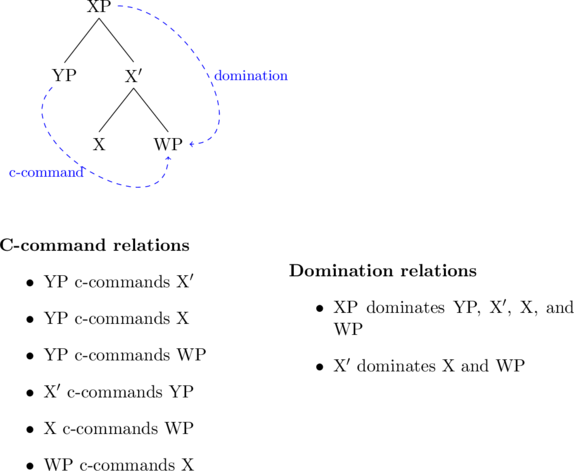
It turns out that c-command matters whenever we talk about non-local dependencies. In this context, “non-local” just means whenever two things interact which aren’t in the same phrase. Binding Theory is a very clear example of the importance of c-command, but it’s influence can be found in a variety of syntactic processes.
C-command (length:1m 34s) Credit: Megan Spurgeon
Things that refer
Gendered language and referring expressions
In this unit, because we are talking about individuals and their properties, we are using a number of terms that are inherently gendered. It is important to note that our use of gendered terms here is purely a linguistic fact, and does not (or should not) reflect our opinions about gender.
In working through the following data, please assume that the individuals in question self-identify as the gender that is indicated. That is, assume that Marta below self-identifies as female, and so we use the pronouns ‘she/her’ when referring to her. If Marta identified as non-binary, and chose the pronouns ‘they/them/their,’ the linguistic facts about the distribution of these pronouns would not change: these pronouns—that is, all pronouns—are subject to Condition B of Binding Theory.
In German, there are three linguistic expressions for referring to an individual. Each one is underlined in the following examples.
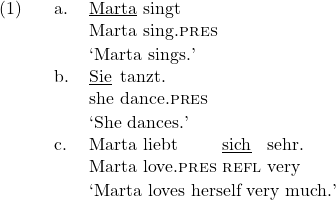
The first way we can refer is to simply use an R-expression which is short for “referential expression.” R-expressions uniquely refer. Marta is an example of an R-expression because there is a unique individual named “Marta” that I’m referring to when I say that word. The reference of Marta never changes. Whenever I use the word Marta, I refer to the individual named by that word. (It is a “rigid designator.”)
In contrast in (2) we see a pronoun, sie. Pronouns can also refer to individuals, but crucially, their reference can change depending context. For instance, sie in (2) likely refers to Marta, but in another context, it could refer to Elise, or Helga, etc. Thus, pronouns and R-expressions share the property of being able to refer, but they differ in that R-expressions have strict reference, while pronouns do not.
Finally in (3), we see a third way to refer to an individual in German: the reflexive anaphor sich. Again, this word refers to an individual. It is used to indicate that Marta loves Marta (not Elise, not Helga, etc). Like pronouns, sich doesn’t always refer to Marta. So in the sentence, Helga liebt sich sehr, then sich refers to Helga. But unlike pronouns, sich‘s reference isn’t totally free. While sie in (2) could, in principle be anyone (who identifies as female), sich in (3) can only be Marta. It cannot be Elise, or Helga, etc.
Summary of referential terms:
- R-expressions
R-expressions strictly refer, meaning that they always refers to the same individual across all contexts. - Pronouns
Pronouns have variable reference, meaning that the individual that they refer to can change depending on context. - Anaphors
Anaphors also have variable reference, because they do not always refer to the same individual. But unlike pronouns, they are not free to refer to anyone. Their reference is fixed in any one context.
This chapter is concerned with the distribution of referential expressions. Even though all three things above can be used to refer to individuals, they all are governed by slightly different rules—and it turns out that these are fundamentally syntactic nature. That is, we will discover that the rules governing when you can and cannot say an R-expression, a pronoun, and a reflexive anaphor are defined purely in terms of syntactic structure.
Constraint on R-Expressions: Condition C
Turning back to German R-expressions (e.g, Marta), pronouns (e.g., sie), and anaphors (e.g., sich), we noted above that all three categories have pretty much the same function: they refer. That is, they pick out an individual or thing. We ‘ll start with the distribution of R-expressions. Consider,
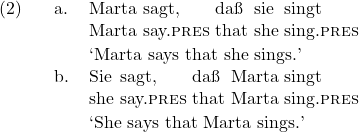
In these sentences, I’ve used two different ways to refer to Marta: an R-expression and a pronoun. In principle, both sentences should be able to mean the same thing, because, as we noted above Marta always mean “Marta,” and sie can mean “Marta” as well.
These sentences do not mean the same thing, though. (2a) means, “Marta says that someone who identifies as female sings.” That “someone” can be anyone, including Marta. So it can mean, “Marta says that Marta sings.” Indeed, that is probably the preferred meaning.
(2b) on the other hand means, “Someone who identifies as female says that Marta sings.” What this sentence absolutely cannot mean, though, is “Marta says that Marta sings.”
We have a way of representing the possible meanings, using indices. I put an index as a subscript on any referring expression. The index is a “pointer.” Anything with the same index points to the same thing. So in (3a), since Marta has the subscript “i”, sie can have the same subscript, i.e., point to the same individual. In (3b), the two expressions cannot be co-indexed. This is what (3c) demonstrates. The two expressions bear different indices, i.e., refer to different individuals.
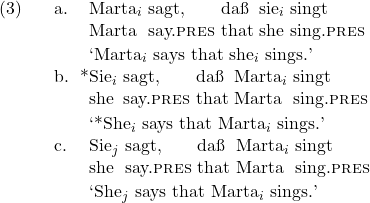
Indices (length: 1m 12s)
Here’s a simple hypothesis about what’s going on in German.
An R-expression cannot be preceded by a co-referential pronoun.
This hypothesis says that the linear order is the problem. It predicts that no matter how long we make the sentence, we still see a similar result. And the data in (4) appear to bear out this prediction!

So Hypothesis #1 looks promising! But here are some counter-examples.

So it’s clear that linear order is not enough. But if linear order isn’t sufficient, then there must be something structural. Let’s look at the trees for a grammatical and ungrammatical sentence. Note that just like in English, possessive pronouns like ihre ‘her’ are analyzed as combinations of a pronoun sie ‘she’ and the possessive determiner ‘s.[1]
Ungrammatical Tree (4)

Grammatical Tree (5a)

In these trees, we observe that in the ungrammatical case, the pronoun sie c-commands the R-expression. In the grammatical case, the pronoun doesn’t. That is, when we look at what sie c-commands in each tree, we find a clear distinction between them. Specifically, we see that when sie c-commands Maria – as in (4), where sie is a sister to T’, and therefore c-commands T’ and everything beneath it (including the R-expression Maria) – the pronoun cannot also refer to Maria. Conversely, we see that when sie doesn’t c-command Maria – as in (5a), where sie instead c-commands D’ (which crucially does not include Maria) – then the pronoun can refer to Maria.
This suggests a different hypothesis:
An R-expression cannot be c-commanded by a co-referential pronoun.
Hypothesis #2 doesn’t care about the linear order, i.e., the order in which we pronounce the words. Instead Hypothesis #2 cares about the hierarchical relationship between the referring expressions. It says that an R-expression cannot be c-commanded by a pronoun if they refer to the same individual. Referring to same individual is called coreference.
We have a specific term for this relationship involving c-command and coreference: binding.
X binds Y iff [if and only if],
- X c-commands Y
- X and Y are co-indexed (i.e., X and Y refer to the same thing).
Hypothesis #2 appears to be empirically correct for German. If we were to look at a lot of data (and control for a lot of factors), we would find that, as a rule, R-expressions cannot be c-commanded by a co-referential pronoun. Indeed, an R-expression cannot be c-commanded by anything co-refential.
This restriction on R-expressions, doesn’t just hold for German. It appears to be a general property of language — basically universal. It is called Condition C (also Principle C) of Binding Theory.
Condition C
An R-expression cannot be bound,
or,
An R-expression must be free. (“Free” means “not bound.”)
A Condition C “violation” involves two things
- The R-expression being c-commanded by a co-referential expression; and
- both expressions referring to the same individual.
If both of these things happen, then Condition C is violated, and the sentence is ungrammatical.
For Binding Theory, we calculate c-command from the phrase level. That is, we always calculate binding by considering the relationship between referential DPs.

This must be the case when we consider, say, possessives. The top DP refers to something that “encompasses” the embedded DP. The only constituent that contains both phrases is the highest DP. The phrase John’s dog refers to a dog, not John.

How to talk about binding
Below are various ways students have talked about binding and binding theory. They are all wrong.
![Rendered by QuickLaTeX.com \Tree [.{\ldots} XP$_i$ [.{\ldots} {\ldots} YP$_i$ ] ]](https://pressbooks.pub/app/uploads/quicklatex/quicklatex.com-52b1a8c89f32288e576da4b318561cdc_l3.png)
- “YP is bound to/with XP” → should be “YP is bound by XP”
- “XP and YP are bound together.” → should be “XP binds YP.”
- “YP is coindexed.” → should be “YP is coindexed with XP.”
- “Y is binded/bounded” → should be “Y is bound.”
- “XP and YP c-command” → should be “XP c-commands YP.”
- “YP is bound by a c-commanding XP” is redundant. Being bound entails being c-commanded.
Things you can say about this binding relationship.
- “XP binds YP.”
- “YP is bound by XP.”
- “XP is a binder for YP, is YP’s binder.”
- “XP c-commands YP.”
- “XP and YP are coindexed,” or “XP and YP have the same index.”
Before turning in assignments, you should check to make sure you’re not making one of these errors.
Constraint on Anaphors: Condition A
Condition C tells us about the distribution of R-expressions. We now turn to anaphors, like German sich. Here are some examples. Pay careful attention to the indices.
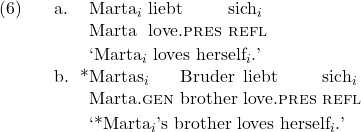
Using the same reasoning as above, we might come to the conclusion that anaphora are governed by rules that are precisely the opposite of R-expressions.
An anaphor must be bound.
That is, unlike an R-expression, an anaphor must be c-commanded by a co-referring expression. This looks pretty good, but it isn’t quite enough. Consider the following sentence. Why does it appear to falsify the hypothesis above?

The problem here is that sich is bound! Marta is coindexed with anaphor, and Marta definitely c-commands the anaphor, since Marta is a the subject of the entire sentence.
It’s possible to keep the idea that anaphors must be bound, but we have to add another clause in our hypothesis. The generalization is that anaphors have to be bound “close enough”. That is, there is some minimal syntactic unit inside of which an anaphor must be bound. We call this minimal syntactic unit the binding domain. For the sake of this class, we’ll say that its the closest TP that dominates the anaphor.
The constraint on anaphors is Condition A of the Binding Theory.
Condition A
An anaphor must be bound in its binding domain (where the binding domain is the closest dominating TP).
For instance, consider the first sentence again,

Here the binding domain for sich is the highest TP—which happens to be the only TP. And because Marta is also inside of this TP, sich is bound, satisfying Condition A. In (7) on the other hand, the binding domain for sich is the lowest TP. Since Marta is not in this TP, sich is free (unbound) and so violates Condition A.
If there are two anaphors in a sentence, they might each have their own binding domain.

Again, Condition A of Binding Theory is universal—although there are some additional complications. First, there may be further constraints on an anaphor in a language. For instance, in English, anaphors must match in number and gender. Assuming that Sue identifies as female, it is not possible to say *Sue loves himself. This not because the anaphor isn’t bound, but because the anaphor doesn’t match the gender.
An additional complication is that the things that look like anaphors in a language often have other (perhaps related) uses. For instance, reflexive pronouns in English are often used colloquially for emphasis.
![]()
Constraint on pronouns: Condition B
Finally, we can look at pronouns. These are actually the most complex. In some ways they’re like R-expressions. Consider the following.
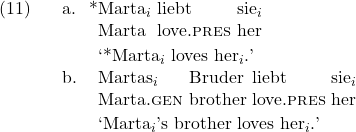
This is similar to Condition C because it looks like the pronoun cannot be bound by a co-referring expression. In (10a), Marta c-commands sie, and they’re co-indexed, so the pronoun is bound. The result is ungrammatical. In contrast, in (10b), the pronoun is free, and the result is grammatical. Based on this data, we therefore posit the following hypothesis:
German Pronoun Hypothesis #1 (to be rejected):
Pronouns are subject to Condition C.
However, if pronouns were just like R-expressions, we would expect the sentence in (11) to be ungrammatical. (For comparison, you can reverse the pronoun and the R-expression, in which case it’s a Condition C violation.)

In fact, pronouns are also a bit like Condition A, in that they make reference to a binding domain (again assumed to be the closest TP). Here’s Condition B of Binding Theory.
Condition B
A pronoun cannot be bound in its binding domain,
or,
A pronoun must be free in its binding domain.
Summary of Binding Theory
- Condition A: An anaphor must be bound in its binding domain.
- Condition B: A pronoun must be free (=cannot be bound) in its binding domain.
- Condition C: An R-expression must be free (=cannot be bound).
We will assume for the purpose of this class that the binding domain for all referential expressions is the closest TP.
A helpful (?) mnemonic:
- Condition A covers anaphors.
- Condition B covers bronouns.
- Condition C is for the other thing: R-expressions.
Using Binding Theory
Because Binding Theory is assumed to be universal, that is, we can detect Conditions A, B, and C, in every language, is extremely helpful in diagnosing structure.
For instance, consider the case of pro-drop languages. These are languages in which a pronominal subject and/or object does not need to be explicitly expressed. Swahili is pro-drop language.
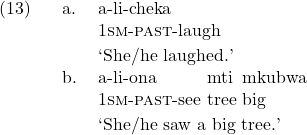
It’s possible to think of pro-drop languages in two different ways.
Hypothesis #1: Pro-drop languages don’t have pronouns. That is, there just isn’t anything in the structure to represent he, she, they, etc.
Hypothesis #2: Pro-drop languages have silent pronouns. That is, there’s a DP pronoun that doesn’t have phonological content.
The two hypotheses are actually widely debated, with many different variations on these hypotheses. The question you can consider, What predictions does each hypothesis make with respect to Binding Theory? For instance, consider the following sentence and its English translation. (Note that Juma is typically a name for a male individual.)

The meaning that is attributed to the sentence in (13) is consistent with only one of the hypotheses above concerning pro-drop languages. Hypothesis 2 predicts that the meaning Hei said that Jumai laughed does not exist because there is a silent pronoun binding the R-expression, thereby violating Condition C. Hypothesis 1 does not predict the unavailability of this meaning. A different explanation would have to be developed.
So Binding Theory can be used to determine structure. This is true even for well-studied languages like English. Consider double object constructions.
![]()
In such example, it looks like the verb show is selecting for two objects, Trisha and a painting. This suggests that double object construction should have a “flat” structure, directly contradicting our X’-schema.

This tree makes very clear predictions though. It says that Trisha c-commands a painting and that a painting c-commands Trisha. They mutually c-command each other. The following data suggest however that this cannot be correct.
![]()
This data suggests that the indirect object, the first object, c-commands the direct object, the second object, but not vice versa. We’ll return to how we can make this syntactically work later. For now, the takeaway is that we can use Binding Theory to determine what the syntax looks like.
Things to remember
- The difference between R-expressions, pronouns, and anaphors
- The difference between Conditions A, B, and C of Binding Theory
- How to use Binding Theory to determine syntactic structure
- C-command
Where we’re going: C-command elsewhere in syntax
We’ve demonstrated here the importance of c-command with respect to Binding Theory. But c-command is evident everywhere is syntax. Whenever we have a non-local dependency, we find that c-command mitigates that dependency in some way. For instance, consider again Head Movement from chapter 7.
It is not clear that Head Movement also obeys c-command: you can only move to the closest c-commanding head.
For instance, recall Head Movement, where a head is allowed to move up the tree “past” other phrases.

The reason that we never see V more to, say, sometimes, is because the head Adv doesn’t c-command V. That is, you can only head-move to a c-commanding head.
We’ll discover soon that there are other types of movement, and those two are constrained by c-command. As a general rule, you can only move to a position that c-commands your starting position. (The exception being head-lowering. ADD MORE)
Advanced
Pronouns are “special.” We’ve discussed above the cases if pronouns that refer, that is, that point to an individuals (or individuals) in the discourse. But pronouns can sometimes have other functions. Consider the following pair of sentences.[2]

The sentences in (17) actually involve two different uses of the pronoun she. In (17a), the most natural reading is that she refers back to Beth.This is the use that we’re familiar with; the pronoun is being used to refer to an individual. But what about (17b). Does she refer to a particular individual? On one reading, the answer is no. There’s a reading of (17b) in she refers to different people. Consider the context in which we are talking about the students Sarah, Nekesa, Maria, and Althea (and each of these individuals identifies as female). We can understand (17b) to mean that “Sarah thinks that Sarah is the smartest” and “Nekesa thinks that Nekesa is the smartest” and “Maria thinks that Maria is the smartest” and “Althea thinks that Althea is the smartest.” That is, as we run through the list of students, she refers to each of the students. (Note that she doesn’t refer to every student: this sentence cannot mean “Every student thinks that every student is the smartest.”)
This reading doesn’t treats she as a referring expressing because the pronoun doesn’t pick out a particular individual in the discourse. Instead, she is a variable; she’s reference varies depending on the associated quantifier. In this case, the quantifier is every.
It turns out that variables have very different properties than referring pronouns: variables must be bound. For instance, the co-varying interpretation of she goes away if there is no c-command.
![]()
In (18), the variable interpretation doesn’t seem to work; we can’t let she mean “each of the students” in this example. (Note the use of indices here: putting an index on every student and she indicates that we should make those two DP’s co-refer.) Variables can be bound “long-distance” as well:
![]()
The takeaway from this is that pronouns in English (and many other languages) have two distinct functions; each function has a distinct distribution.
Variable pronouns have variable reference and must be bound by a quantified expression.
- These trees slightly simplify German's syntax. German has a special property called "V2." In German, the finite verb is always the second thing in the sentence in main clauses. This is derived by V-to-C movement. In embedded clauses, however, we discover that German is actually verb-final (SOV) when the verb does not move to C. ↵
- Many people nowadays prefer the non-gendered "singular they" instead of she in sentences like this. There are prescriptive rules against this kind of singular they, it has been standard usage for hundreds of years. ↵
Movement of heads. Head-movement is constrained by the Head-Movement Constraint. Haed-movement is distinct from Phrasal Movement.
A dominates B if A is above B in a tree. A immediately dominates B if A dominates B and there are no other projections that dominate B which do not dominate A.
A referring expressions. R-expressions strictly refer, meaning that their reference cannot change in context.
A referring expression. A pronoun's reference is not strict, meaning that it can change depending on context. Note that pronouns are not nouns, they are syntactically determiners.
A referring expression, also called an anaphor. A reflexives reference is not strict, meaning that it can change depending on context, but it is also sensitive to syntactic structure. Reflexives are subject to Condition A of binding theory.
A and B corefer if they refer to the same individual(s).
The condition of binding theory that governs R-expressions. "R-expressions cannot be bound."
A binding domain is a minimal distance that some element makes reference to in its distribution. The binding domain for this class is the nearest dominating TP.
A DP is free if it is not bound, i.e., c-commanded by a coreferential expression.
A typological phenomenon characterized by the ability to have apparently silent pronouns. Languages like Spanish, Italian, and Swahili are pro-drop languages.
